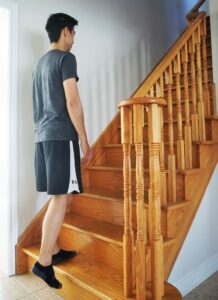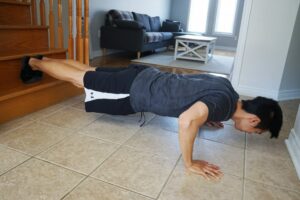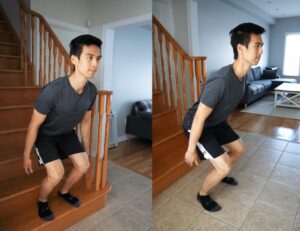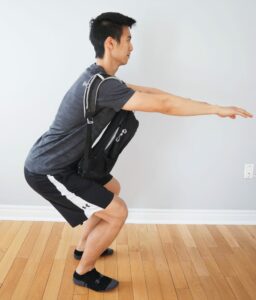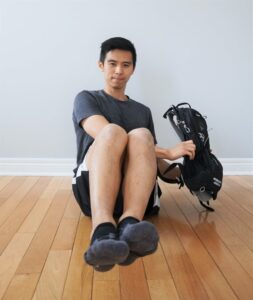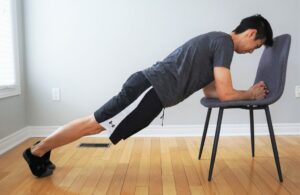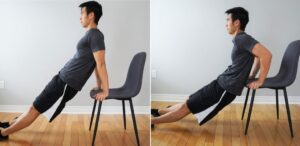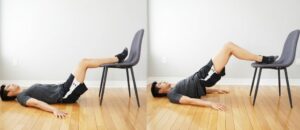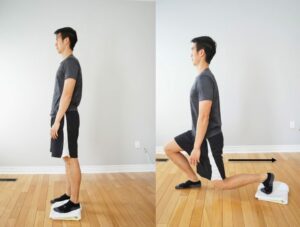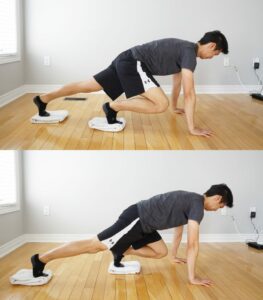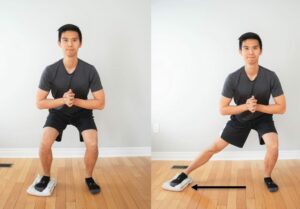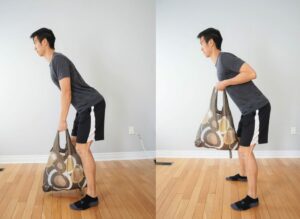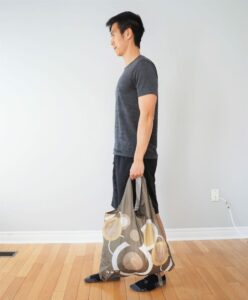Call Us
by Cedric Quach
Registered Physiotherapist
updated July 15, 2020
Going to the gym is a luxury that many of us take for granted. You simply drive to a fitness centre, change into your exercise clothes, and have access to weights that are perfectly shaped and machines that are fully customizable to your specifications. Now that you’re stuck at home, you’re probably wondering, “how am I going to maintain my fitness now with no access to equipment?”
The answer is simple, use common household items that you see everyday. If you are willing to compromise and use items that are not conveniently sized or a chair that is not adjustable, you can still get and effective and challenging workout at home.
How do I work out without a gym?
Despite common belief, having access to advanced fitness equipment is not the only method to build strength. Theoretically, anything that has weight or provides you the means to exert resistance can help build fitness. For example, have you ever seen that person at the park doing pull-ups on monkey bars or push-ups with their feet on a bench? That person is an example of someone who is building fitness using easily accessible ‘equipment’. With some creativity and everyday household items, it is surprising how many exercises you can do at home.
How much space do I need to work out at home?
The amount of space you will need depends on the type of exercises you decide to incorporate into your fitness program. Most exercises, however, require minimal space unless it involves a large dynamic movement, like a walking lunge. If your exercise program will only require you to stand, sit, and lay on your back (ex. push-ups, sit-ups, squats), we recommend that you allocate a floor space that is a little wider than your arm-span and slightly longer than your height.
What common household items can I use for exercise?
The number of household items that can double as exercise equipment is endless with some creativity.
Here we will highlight the top 5 most common household items that people use for their home workouts, along will some suggestions on how to use them.
BEST STAIR EXERCISES
Having access to a set of stairs is fairly universal whether you live in a house or condominium. If stairs are not easily accessible to you, they are often available at a nearby park. A step can also be used for these exercises. For safety purposes, please ensure that the step is stable and place it against a wall to prevent it from slipping.
Step-ups
- Step up and down the first step of your stairs
- To target your cardiovascular system, we recommend stepping up and down at a constant, moderate intensity for at least 15 minutes
- To build strength, we recommend holding onto a heavy object (ex. grocery bag, backpack, etc.), aiming to fatigue your legs within 10-15 repetitions
Split Squat
- Stand facing away from the set of stairs
- Place one foot onto the step behind you
- Ensure that there is a large gap between both feet
- Lower yourself into a lunge with the aim of bringing the back knee close to the ground
Push-up
- Get into a push-up position with both feet on the steps
- Maintain a straight back
- Bend both elbows and lower your body close to the ground
Box Jumps
- Stand on the first step, facing the floor
- Lower yourself into a squat and jump off the step
- Land lightly on your forefoot and lower yourself into a squat to cushion the landing
- For safety reasons, we do not recommend that you jump onto a step
BEST BACKPACK EXERCISES
In theory, anything that is weighted can be used for exercise. However, it may not always be practical as household objects come in all shapes and sizes. Backpacks are great as you can customize the weight depending on their contents. In addition, your hands will be free while exercising.
Standing squat
- Wear the backpack in front of you to keep the weight centered
- As you lower yourself into a squat, keep your back straight and move your hips back, as if you’re sitting onto a chair
- Lower your body as far as you can without allowing your heels to lift off the ground
Shoulder press
- Start in a standing position with the backpack at chest level
- Engage your core and lift the backpack above your head
- Avoid arching your back as your lifting the backpack, as it will produce unintended strain on your back
Deadlift
- Start with the backpack standing on the ground either just in front or between your legs
- Bend forward from the hips while maintaining a straight spine to reach the backpack with your arms.
- Slowly rise while tracing the backpack along the front of your leg to avoid increased strain on your lower back
Russian Twist
- Sit with both knees bent
- Hold onto the backpack with both hands
- Lean backwards and lift both legs off the ground
- Rotate your torso and place the bag beside one hip
- Rotate in the opposite direction and place the bag beside the other hip
- Maintain a straight back through the process
BEST CHAIR EXERCISES
When using a chair, we recommend that you use a standard-sized chair. When sitting in the chair, your knees should be bent at 90 degrees and your feet should be flat on the ground. A chair with a higher backrest will provide increased stability. For safety purposes, we recommend that you do not use a chair with wheels and place the chair against a wall to prevent it from slipping.
Chair Plank
- Begin in a kneeling position in front of the chair with both forearms on the seat
- Lift your knees off the ground and create a straight line from your heels to your shoulder
- Maintain a straight back and hold while engaging the core
Tricep Dips
- Start by sitting on the edge of the chair
- Place both palms on the chair with the fingers facing forward and slightly curled over the edge
- Shift your weight forward and off the chair
- Lower towards the floor by bending both elbows
- The difficulty of the exercise can be increased by keeping both legs straight
Single Leg Squats
- Stand in front of the chair with both knees touching the chair
- Lift one leg off the ground
- Slowly bend your knee and lower onto the chair
- When standing back up, you can stand with one or both legs
Bridge
- Lay on your back with your knees bent in front of the chair
- Spread your arms out to the side to create a wider base of support
- Place both feet on the chair
- Lift your hips off the ground until your back is straight
BEST TOWEL EXERCISES
Towels are a common household item that is often overlooked to be a valuable exercise tool. When placed on hardwood floor or tiles, it can be used as a substitution for a glider disk.
Hamstring Curls
- Lay on your back with both knees bent
- Place the towel under both feet
- Lift your pelvis off the ground to get into a bridge position
- Slowly use your feet to the slide the towel away from you
- You will notice increased tension along the hamstring and gluts
- Return to the starting position and repeat
Rear Lunge
- Stand with one foot on a towel
- Slowly shift the foot backwards and lower into a lunge position
- Aim to bring the back knee towards the ground to maintain proper form
- Keep your back straight through the movement pattern
Mountain Climbers
- Start on all fours with one towel under each feet
- Lift your knees off the ground and slide both feet backwards until you reach a plank position
- Slide one foot forward, aiming to bring your knee closer to your chest
- Alternate from side to side
- Remember to keep your core engaged to assist with maintain stability through the movement pattern
Squat Slides
- Place one towel under one foot
- Lower yourself into a squat
- While maintaining this position, slide the leg with the towel to the side
- As you slide your leg, you should feel increased tension on the stationary leg
BEST GROCERY BAG EXERCISES
The advantage of using grocery bags as a weighted object is that it comes with two handles. In addition, you can modify the weight by adjusting the number or type of objects you decide to put in the bag. When choosing the type of bag to use, we recommend that you avoid thin plastic bags, which may rip while exercising. Instead, we recommend a medium-sized reusable grocery bag as they are more durable. Avoid using larger-sized bags as the objects will shift in the bag and will make them harder to work with.
Bent-over row
- Begin in a standing position while holding one handle with each hand
- Widen your stance so that the bag can easily fit between both legs
- Lower yourself into a half squat
- Maintain this position and pull the bag towards your chest
- Remember to keep a straight back to prevent increased strain on your lower back
Farmer’s Walk
- Load the bag with heavier objects until you feel that the bag is pulling you towards one side when holding it with one hand
- Begin by correcting your posture by engaging your core and lifting your shoulder blade up and back
- Start walking while maintaining proper posture
- You should feel your core and shoulder stabilizers engage if done properly
Kettlebell swing
- Begin with the grocery bag slightly in front of your feet
- Bend your slightly and hinge through the hip
- Hold onto the grocery bag handles with both hands
- Swing the bag between your legs to begin creating a momentum
- Quickly straighten your knees, hips, and back to drive the weight forward
- The grocery bag should elevate just above your shoulders
Bicep Curl to Overhead Press
- In a standing position, hold the handle of the grocery bag with one hand
- Bend the elbow to curl the weight up to your shoulder height
- Turn your palm so that it’s facing forward and push grocery bag up until your elbow is fully straightened
Final Thoughts
In summary, any object that is weighted or provides you the means to exert resistance can be used for exercise. The list that we provided is not exhaustive and with some creativity, you may be surprised the number of items you’ll be able to find for your exercise program.
If you have any questions or require assistance with setting up a home exercise program, we recommend that you set up an appointment with of our physiotherapists. Our team of physiotherapists have extensive training in building exercise programs and will be able to help you build a fitness routine customized to your setting. If you would like to speak with us first, we offer a complementary 10-minute phone consult with a Registered Physiotherapist.
Cedric Quach MScPT
Registered Physiotherapist
Cedric is a highly credentialed physiotherapist working in Cornerstone’s North York clinic. He successfully treats a wide variety of patient impairments from orthopaedic and sports injuries to concussion and vestibular conditions. He knows that the key ingredient in the recipe for recovery involves creative exercise modifications that are specific to every patient’s home environment.
To learn more about Cedric, click here.

Questions? We're happy to help!
Choosing the right service provider can be a big decision. We’re dedicated to answering any questions you have to help you make the best choice. Contact us today and ask us anything!
Call us at (416) 238-6749





